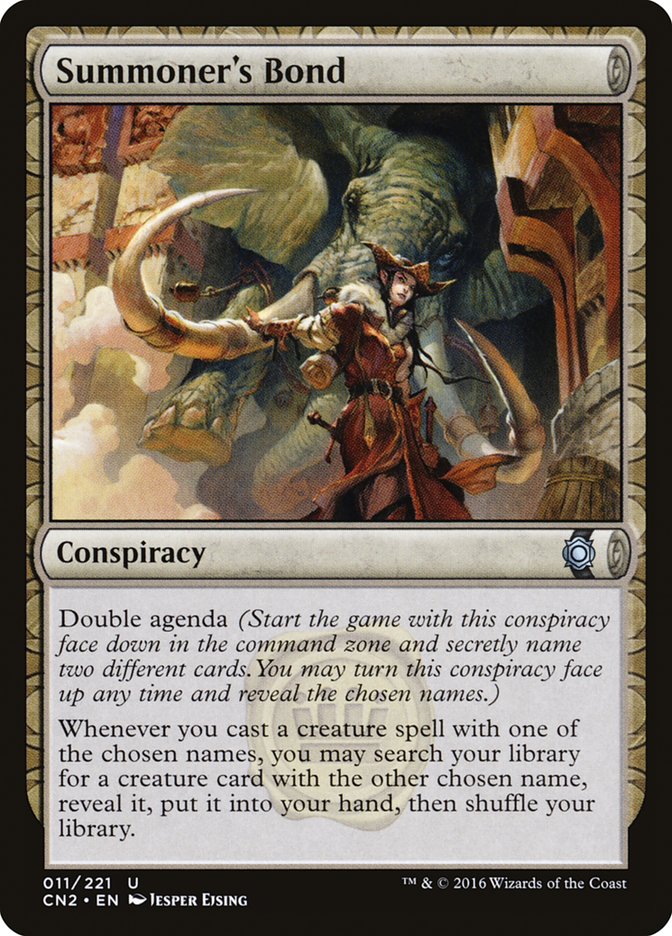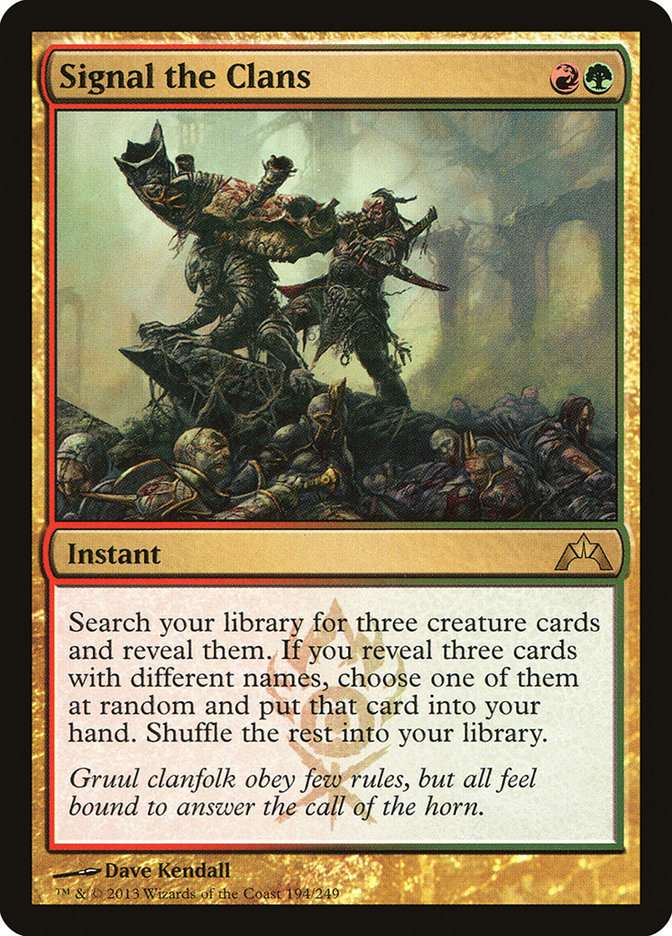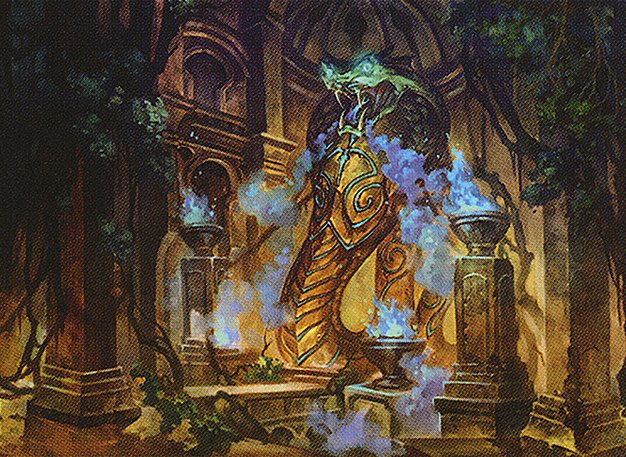Summoner's Bond MTG Card
| Rarity | Uncommon |
| Type | Conspiracy |
| Abilities | Double agenda |
| Released | 2016-08-26 |
| Set symbol | |
| Set name | Conspiracy: Take the Crown |
| Set code | CN2 |
| Number | 11 |
| Frame | 2015 |
| Layout | Normal |
| Border | Black |
| Illustred by | Jesper Ejsing |
Key Takeaways
- It enhances deck synergy by tutoring creatures that share a type, boosting board presence and hand resources.
- Instant speed casting of Summoner’s Bond offers strategic flexibility during your opponent’s turn or before yours.
- While offering strong combo potential, the card’s discard requirement and specific mana cost could limit its use.
Text of card
Double agenda (Start the game with this conspiracy face down in the command zone and secretly name two different cards. You may turn this conspiracy face up any time and reveal the chosen names.) Whenever you cast a creature spell with one of the chosen names, you may search your library for a creature card with the other chosen name, reveal it, put it into your hand, then shuffle your library.
Card Pros
Card Advantage: Summoner’s Bond offers the potential to streamline your deck’s synergy by specifically tutoring for two creatures that share a creature type. This not only increases the number of creatures in your hand but also ensures they work well together, boosting your position on the board.
Resource Acceleration: Though not directly providing mana, Summoner’s Bond can be a form of indirect resource acceleration. By fetching key creatures into your hand, it accelerates your game plan and allows you to deploy threats or enablers more efficiently.
Instant Speed: The ability to cast Summoner’s Bond at instant speed adds a layer of versatility. It allows you to wait until the last possible moment before deciding which creatures to reveal, giving you the flexibility to adapt to the evolving state of the game.
Card Cons
Discard Requirement: Summoner’s Bond necessitates that players discard a card in order to utilize its ability. This can be a significant downside during gameplay, particularly when hand size is crucial and every card counts.
Specific Mana Cost: The mana cost for Summoner’s Bond is strict, requiring not just any mana but a combination that fits into its color identity. This can restrict the card’s inclusion in a variety of decks, especially those with a broader color palette.
Comparatively High Mana Cost: With a mana value that could be deemed on the higher end for its capabilities, Summoner’s Bond competes with other cards that may provide similar or greater value for the same or lower mana investment, potentially making it a less appealing choice for deck builders focused on efficiency.
Reasons to Include in Your Collection
Versatility: Summoner’s Bond offers flexible usage across a variety of deck themes, as it allows players to form a unique synergy between creatures. It can be a strong addition to decks focusing on creature-based strategies or those that play around specific creature types.
Combo Potential: This card opens up a plethora of combo possibilities. By naming two creatures that benefit each other when they enter the battlefield, players can set up powerful interactions that could potentially swing the game in their favor.
Meta-Relevance: Given its capacity to support creature-heavy tactics, Summoner’s Bond can become quite a utility in a meta that favors such strategies. It allows for adaptive gameplay that can help players outmaneuver opponents adhering to popular trends.
How to beat
Summoner’s Bond introduces a tactical twist to deck construction in the world of Magic: The Gathering. Much like cards that synergize with creature types, Summoner’s Bond allows players to capitalize on the presence of a paired creature. However, strategies to dismantle the effectiveness of Summoner’s Bond exist within the game’s deep pool of mechanics.
To counteract Summoner’s Bond, disruption is key. Employing removal spells at the right moment can sever the bond before it yields value. Anything from targeted removal like Path to Exile to board wipes like Doomskar can disrupt the intended combo. Moreover, counter spells that negate Summoner’s Bond before it ever hits the battlefield remain an efficient method to thwart an opponent’s game plan. It is essential to recognize the pivotal role of timing in these actions, as waiting for your opponent to commit resources before neutralizing their play can shift the game in your favor.
Adapting to the dynamics of Magic: The Gathering often requires foresight and an understanding of the metagame. Cards such as Summoner’s Bond offer intriguing possibilities, but with prudent play and well-timed reactions, their impact can be effectively mitigated in competitive play.
Cards like Summoner's Bond
Summoner’s Bond introduces a unique twist in player interaction and strategic planning in Magic: The Gathering. It runs parallel to cards like Diabolic Tutor or Idyllic Tutor which enable players to search their library for cards to put into their hands. While these tutors are versatile in their selection, Summoner’s Bond stands out by allowing players to name two cards, further weaving a tale of comradeship between chosen creatures or a creature and a noncreature card as they enter the battlefield together.
Another comparable card is Tooth and Nail. This potent spell not only tutors creatures but, if entwined, puts them directly onto the battlefield, bypassing hand and casting cost. Summoner’s Bond, while not placing the creatures on the battlefield, does not require the same heavy mana investment. Signal the Clans is another similar effect, presenting a randomized element by fetching three creatures and randomly giving you one, contrasting with Summoner’s Bond’s specificity.
Choosing the right tutor can significantly influence the course of the game. Summoner’s Bond’s unique dual-card searching capability truly enriches the deck building and strategy, cementing its place as a cornerstone for synergetic deck designs in the diverse world of Magic: The Gathering.
Where to buy
If you're looking to purchase Summoner's Bond MTG card by a specific set like Conspiracy: Take the Crown, there are several reliable options to consider. One of the primary sources is your local game store, where you can often find booster packs, individual cards, and preconstructed decks from current and some past sets. They often offer the added benefit of a community where you can trade with other players.
For a broader inventory, particularly of older sets, online marketplaces like TCGPlayer, Card Kingdom and Card Market offer extensive selections and allow you to search for cards from specific sets. Larger e-commerce platforms like eBay and Amazon also have listings from various sellers, which can be a good place to look for sealed product and rare finds.
Additionally, Magic’s official site often has a store locator and retailer lists for finding Wizards of the Coast licensed products. Remember to check for authenticity and the condition of the cards when purchasing, especially from individual sellers on larger marketplaces.
Below is a list of some store websites where you can buy the Summoner's Bond and other MTG cards:
- eBay
- TCG Player
- Card Kingdom
- Card Market
- Star City Games
- CoolStuffInc
- MTG Mint Card
- Hareruya
- Troll and Toad
- ABU Games
- Card Hoarder Magic Online
- MTGO Traders Magic Online
See MTG Products
Legalities
Magic the Gathering formats where Summoner's Bond has restrictions
| Format | Legality |
|---|---|
| Commander | Banned |
| Legacy | Banned |
| Oathbreaker | Banned |
| Vintage | Banned |
| Duel | Banned |
Rules and information
The reference guide for Magic: The Gathering Summoner's Bond card rulings provides official rulings, any errata issued, as well as a record of all the functional modifications that have occurred.
| Date | Text |
|---|---|
| 2016-08-23 | A conspiracy doesn’t count as a card in your deck for purposes of meeting minimum deck size requirements. (In most drafts, the minimum deck size is 40 cards.) |
| 2016-08-23 | A conspiracy with hidden agenda that has a triggered ability must be face up before that ability’s trigger condition is met in order for it to trigger. Turning it face up afterward won’t have any effect. |
| 2016-08-23 | A conspiracy’s static and triggered abilities function as long as that conspiracy is face-up in the command zone. |
| 2016-08-23 | As a special action, you may turn a face-down conspiracy face up. You may do so any time you have priority. This action doesn’t use the stack and can’t be responded to. Once face up, the named card is revealed and the conspiracy’s abilities will affect the game. |
| 2016-08-23 | At the end of the game, you must reveal any face-down conspiracies you own in the command zone to all players. |
| 2016-08-23 | At the end of the game, you must reveal any face-down conspiracies you own in the command zone to all players. Notably, you can’t bluff conspiracies with hidden agenda by putting other cards into the command zone face down as the game starts. |
| 2016-08-23 | Conspiracies are colorless, have no mana cost, and can’t be cast as spells. |
| 2016-08-23 | Conspiracies are never put into your deck. Instead, you put any number of conspiracies from your card pool into the command zone as the game begins. These conspiracies are face up unless they have hidden agenda, in which case they begin the game face down. |
| 2016-08-23 | Conspiracies aren’t legal for any sanctioned Constructed format, but may be included in other Limited formats, such as Cube Draft. |
| 2016-08-23 | Double agenda is a variant of hidden agenda. The only difference is you secretly name two different cards instead of one. |
| 2016-08-23 | If you play multiple games after the draft, you can name a different card in each new game. |
| 2016-08-23 | The last ability of Summoner’s Bond will resolve before the creature spell that caused it to trigger. |
| 2016-08-23 | There are several ways to secretly name a card, including writing the name on a piece of paper that’s kept with the face-down conspiracy. If you have multiple face-down conspiracies, you may name a different card for each one. It’s important that each named card is clearly associated with only one of the conspiracies. |
| 2016-08-23 | You can look at any player’s face-up conspiracies at any time. You’ll also know how many face-down conspiracies a player has in the command zone, although you won’t know what they are. |
| 2016-08-23 | You don’t have to play with any conspiracy you draft. However, you have only one opportunity to put conspiracies into the command zone, as the game begins. You can’t put conspiracies into the command zone after this point. |
| 2016-08-23 | You must name a Magic card. Notably, you can’t name a token (except in the unusual case that a token’s name matches the name of a card, such as Illusion). |
| 2016-08-23 | You name the card as the game begins, as you put the conspiracy into the command zone, not as you turn the face-down conspiracy face up. |













